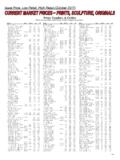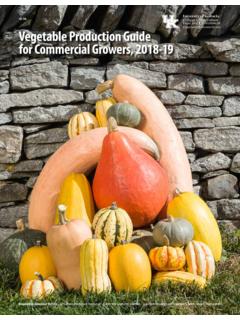Transcription of Surveillance of influenza and other respiratory viruses in ...
1 Surveillance of influenza and other respiratory viruses in the UK. winter 2018 to 2019. Surveillance of influenza and other respiratory viruses in the UK: winter 2018 to 2019. About Public Health England Public Health England exists to protect and improve the nation's health and wellbeing, and reduce health inequalities. We do this through world-leading science, knowledge and intelligence, advocacy, partnerships and the delivery of specialist public health services. We are an executive agency of the Department of Health and Social Care, and a distinct delivery organisation with operational autonomy.
2 We provide government, local government, the NHS, Parliament, industry and the public with evidence-based professional, scientific and delivery expertise and support. Public Health England Wellington House 133-155 Waterloo Road London SE1 8UG. Tel: 020 7654 8000. Twitter: @PHE_uk Facebook: Prepared by: influenza Surveillance Team, Immunisation and Countermeasures Division, National Infection Service, PHE. For queries relating to this document, please contact: Crown copyright 2019. You may re-use this information (excluding logos) free of charge in any format or medium, under the terms of the Open Government Licence To view this licence, visit OGL.
3 Where we have identified any third party copyright information you will need to obtain permission from the copyright holders concerned. Published May 2019. PHE publications PHE supports the UN. gateway number: GW-444 Sustainable Development Goals 2. Surveillance of influenza and other respiratory viruses in the UK: winter 2018 to 2019. Contents About Public Health England 2. Executive summary 4. Background 6. Observations 8. Community Surveillance 8. Outbreak reporting 12. Medical Officers of Schools Association (MOSA) and PHE scheme 14. Google influenza like illness (ILI) searches (internet-based Surveillance ) 16.
4 Primary care consultations 17. Secondary care Surveillance 21. USISS Mandatory 24. USISS Severe respiratory Failures Centre (SRF) 30. Microbiological Surveillance 31. Vaccination 37. Seasonal influenza vaccine uptake in adults 37. influenza vaccine (LAIV) programme for children 40. Vaccine effectiveness 44. other respiratory viruses 45. Excess all-cause mortality Surveillance 49. Paediatric mortality 50. influenza -attributable deaths 50. Emerging respiratory viruses 52. Human MERS-CoV infections 52. Human influenza A(H7N9) infections 53. Human influenza A(H5N1) and influenza A(H5N6) infections 53.
5 Conclusions 54. Acknowledgments 56. Appendix A 57. 3. Surveillance of influenza and other respiratory viruses in the UK: winter 2018 to 2019. Executive summary In the 2018 to 2019 season, low to moderate levels of influenza activity were observed in the community with circulation of influenza A(H1N1)pdm09 followed by influenza A(H3N2) in the latter part of the season. Activity started in week 01, with the length and peak of activity in general practice varying across the UK, reaching low levels in England, Scotland and Northern Ireland and medium levels in Wales. influenza transmission resulted in high impact on secondary care in terms of hospitalisations and ICU admissions.
6 The impact of A(H1N1)pdm09 was predominantly seen in the younger age groups (15-44 and 45-64 years) in both GP consultations and hospital and ICU/HDU influenza admissions. Peak admission rates of influenza to hospital and ICU were similar or slightly lower than seen in 2017 to 2018 but higher than all other seasons since 2010 to 2011. Levels of excess all-cause mortality were the lowest seen since 2013 to 2014 in England, although both Scotland and Northern Ireland observed weeks with significant excess mortality for all ages (3 weeks and 2. weeks respectively) including in the 65+ year olds (2 weeks for both).
7 The UK, as with many Northern Hemisphere countries found that the majority of circulating influenza A(H1N1)pdm09 and A(H3N2) strains that were characterised were genetically and antigenically similar to the Northern Hemisphere 2018 to 2019. A(H1N1)pdm09 and A(H3N2) vaccine virus strains. influenza vaccine uptake in 2018 to 2019 in England for the 65+ year olds was slightly lower than that seen in 2017 to 2018 . The vaccine uptake in 2018 to 2019 was also lower than the 2017 to 2018 season for those aged 6 months to under 65 years of age with 1 or more underlying clinical risk factors ( ) and pregnant women ( ).
8 Vaccine uptake for health care workers in 2018 to 2019 increased to compared to in 2017 to 2018 . In 2018 to 2019, the universal childhood influenza vaccine programme with live attenuated influenza vaccine (LAIV) was again offered to all 2 and 3 year olds across the UK, plus to all children of school age Reception, Year 1, 2, 3, 4. and 5 in England. Uptake in 2 and 3 year olds was and in school age children reception to school year 5 was In Scotland and Northern Ireland, where vaccination was offered to all primary school children, the uptake in the 2 to <5 year olds (not yet in school) was and respectively, a decrease from the previous season ( and , respectively).
9 Uptake in all primary school children (4 to 11 year olds) was in Scotland (compared to in 2017 to 2018 ) and in Northern Ireland (compared to in 2017 to 2018 ). 2018 to 2019 was the first season vaccination was offered to all primary school children in Wales with an overall uptake of and uptake in 2 and 3 year olds was Overall influenza vaccine effectiveness in 2018 to 2019 against a laboratory confirmed infection resulting in a primary care consultation was (95% CI to ). 4. Surveillance of influenza and other respiratory viruses in the UK: winter 2018 to 2019. Activity from other circulating seasonal respiratory viruses was similar overall compared to levels reported in recent years.
10 Two novel respiratory viruses which emerged in 2012. to 2013, Middle East respiratory Syndrome coronavirus (MERS-CoV) in the Middle East and avian-origin influenza A(H7N9) in Eastern China, have continued to result in human cases in affected countries. One imported human case of MERS-CoV infection was detected in the UK in August 2018 . No onward transmission to close contacts occurred. Surveillance and public health measures established in the UK for travellers returning with severe respiratory disease from affected countries are on-going. 5. Surveillance of influenza and other respiratory viruses in the UK: winter 2018 to 2019.













